Target Information
| Target General Information | Top | |||||
|---|---|---|---|---|---|---|
| Target ID |
T53524
(Former ID: TTDC00311)
|
|||||
| Target Name |
Platelet-derived growth factor receptor alpha (PDGFRA)
|
|||||
| Synonyms |
RHEPDGFRA; Platelet-derived growth factor receptor 2; Platelet-derived growth factor alpha receptor; PDGFR2; PDGFR-alpha; PDGFR-2; PDGF-R-alpha; CD140a antigen; CD140a; CD140 antigen-like family member A; Alpha-type platelet-derived growth factor receptor; Alpha platelet-derived growth factor receptor
Click to Show/Hide
|
|||||
| Gene Name |
PDGFRA
|
|||||
| Target Type |
Successful target
|
[1] | ||||
| Disease | [+] 3 Target-related Diseases | + | ||||
| 1 | Gastrointestinal stromal tumour [ICD-11: 2B5B] | |||||
| 2 | Kaposi sarcoma [ICD-11: 2B57] | |||||
| 3 | Thrombocytopenia [ICD-11: 3B64] | |||||
| Function |
Depending on the context, promotes or inhibits cell proliferation and cell migration. Plays an important role in the differentiation of bone marrow-derived mesenchymal stem cells. Required for normal skeleton development and cephalic closure during embryonic development. Required for normal development of the mucosa lining the gastrointestinal tract, and for recruitment of mesenchymal cells and normal development of intestinal villi. Plays a role in cell migration and chemotaxis in wound healing. Plays a role in platelet activation, secretion of agonists from platelet granules, and in thrombin-induced platelet aggregation. Binding of its cognate ligands - homodimeric PDGFA, homodimeric PDGFB, heterodimers formed by PDGFA and PDGFB or homodimeric PDGFC -leads to the activation of several signaling cascades; the response depends on the nature of the bound ligand and is modulated by the formation of heterodimers between PDGFRA and PDGFRB. Phosphorylates PIK3R1, PLCG1, and PTPN11. Activation of PLCG1 leads to the production of the cellular signaling molecules diacylglycerol and inositol 1,4,5-trisphosphate, mobilization of cytosolic Ca(2+) and the activation of protein kinase C. Phosphorylates PIK3R1, the regulatory subunit of phosphatidylinositol 3-kinase, and thereby mediates activation of the AKT1 signaling pathway. Mediates activation of HRAS and of the MAP kinases MAPK1/ERK2 and/or MAPK3/ERK1. Promotes activation of STAT family members STAT1, STAT3 and STAT5A and/or STAT5B. Receptor signaling is down-regulated by protein phosphatases that dephosphorylate the receptor and its down-stream effectors, and by rapid internalization of the activated receptor. Tyrosine-protein kinase that acts as a cell-surface receptor for PDGFA, PDGFB and PDGFC and plays an essential role in the regulation of embryonic development, cell proliferation, survival and chemotaxis.
Click to Show/Hide
|
|||||
| BioChemical Class |
Kinase
|
|||||
| UniProt ID | ||||||
| EC Number |
EC 2.7.10.1
|
|||||
| Sequence |
MGTSHPAFLVLGCLLTGLSLILCQLSLPSILPNENEKVVQLNSSFSLRCFGESEVSWQYP
MSEEESSDVEIRNEENNSGLFVTVLEVSSASAAHTGLYTCYYNHTQTEENELEGRHIYIY VPDPDVAFVPLGMTDYLVIVEDDDSAIIPCRTTDPETPVTLHNSEGVVPASYDSRQGFNG TFTVGPYICEATVKGKKFQTIPFNVYALKATSELDLEMEALKTVYKSGETIVVTCAVFNN EVVDLQWTYPGEVKGKGITMLEEIKVPSIKLVYTLTVPEATVKDSGDYECAARQATREVK EMKKVTISVHEKGFIEIKPTFSQLEAVNLHEVKHFVVEVRAYPPPRISWLKNNLTLIENL TEITTDVEKIQEIRYRSKLKLIRAKEEDSGHYTIVAQNEDAVKSYTFELLTQVPSSILDL VDDHHGSTGGQTVRCTAEGTPLPDIEWMICKDIKKCNNETSWTILANNVSNIITEIHSRD RSTVEGRVTFAKVEETIAVRCLAKNLLGAENRELKLVAPTLRSELTVAAAVLVLLVIVII SLIVLVVIWKQKPRYEIRWRVIESISPDGHEYIYVDPMQLPYDSRWEFPRDGLVLGRVLG SGAFGKVVEGTAYGLSRSQPVMKVAVKMLKPTARSSEKQALMSELKIMTHLGPHLNIVNL LGACTKSGPIYIITEYCFYGDLVNYLHKNRDSFLSHHPEKPKKELDIFGLNPADESTRSY VILSFENNGDYMDMKQADTTQYVPMLERKEVSKYSDIQRSLYDRPASYKKKSMLDSEVKN LLSDDNSEGLTLLDLLSFTYQVARGMEFLASKNCVHRDLAARNVLLAQGKIVKICDFGLA RDIMHDSNYVSKGSTFLPVKWMAPESIFDNLYTTLSDVWSYGILLWEIFSLGGTPYPGMM VDSTFYNKIKSGYRMAKPDHATSEVYEIMVKCWNSEPEKRPSFYHLSEIVENLLPGQYKK SYEKIHLDFLKSDHPAVARMRVDSDNAYIGVTYKNEEDKLKDWEGGLDEQRLSADSGYII PLPDIDPVPEEEDLGKRNRHSSQTSEESAIETGSSSSTFIKREDETIEDIDMMDDIGIDS SDLVEDSFL Click to Show/Hide
|
|||||
| 3D Structure | Click to Show 3D Structure of This Target | AlphaFold | ||||
| Drugs and Modes of Action | Top | |||||
|---|---|---|---|---|---|---|
| Approved Drug(s) | [+] 3 Approved Drugs | + | ||||
| 1 | Olaratumab | Drug Info | Approved | Soft tissue sarcoma | [3] | |
| 2 | Ripretinib | Drug Info | Approved | Gastrointestinal stromal tumour | [4] | |
| 3 | Romiplostim | Drug Info | Approved | Thrombocytopenia | [5], [6] | |
| Clinical Trial Drug(s) | [+] 5 Clinical Trial Drugs | + | ||||
| 1 | CP-868596 | Drug Info | Phase 3 | Gastrointestinal cancer | [7], [8] | |
| 2 | E-3810 | Drug Info | Phase 3 | Solid tumour/cancer | [9], [10] | |
| 3 | MEDI-575 | Drug Info | Phase 2 | Glioblastoma multiforme | [13] | |
| 4 | MP470 | Drug Info | Phase 2 | Solid tumour/cancer | [14], [15], [16] | |
| 5 | XL-820 | Drug Info | Phase 2 | Solid tumour/cancer | [17] | |
| Patented Agent(s) | [+] 1 Patented Agents | + | ||||
| 1 | PMID28460551-Compound-1 | Drug Info | Patented | Breast cancer | [18] | |
| Discontinued Drug(s) | [+] 2 Discontinued Drugs | + | ||||
| 1 | SRI-62-834 | Drug Info | Discontinued in Phase 2 | Solid tumour/cancer | [19] | |
| 2 | CEP-2563 | Drug Info | Discontinued in Phase 1 | Solid tumour/cancer | [20] | |
| Mode of Action | [+] 2 Modes of Action | + | ||||
| Modulator | [+] 3 Modulator drugs | + | ||||
| 1 | Olaratumab | Drug Info | [21] | |||
| 2 | CP-868596 | Drug Info | [22], [23] | |||
| 3 | MP470 | Drug Info | [15], [16] | |||
| Inhibitor | [+] 84 Inhibitor drugs | + | ||||
| 1 | Ripretinib | Drug Info | [4] | |||
| 2 | Romiplostim | Drug Info | [1] | |||
| 3 | E-3810 | Drug Info | [24] | |||
| 4 | XL-820 | Drug Info | [25] | |||
| 5 | PMID28460551-Compound-1 | Drug Info | [18] | |||
| 6 | Pyridine derivative 18 | Drug Info | [26] | |||
| 7 | Pyridine derivative 19 | Drug Info | [26] | |||
| 8 | Pyridine derivative 20 | Drug Info | [26] | |||
| 9 | Pyridine derivative 21 | Drug Info | [26] | |||
| 10 | Pyridine derivative 22 | Drug Info | [26] | |||
| 11 | SRI-62-834 | Drug Info | [27] | |||
| 12 | CEP-2563 | Drug Info | [28] | |||
| 13 | AG1295 | Drug Info | [29] | |||
| 14 | RG-13022 | Drug Info | [30] | |||
| 15 | (1H-indol-2-yl)(5-methoxy-1H-indol-2-yl)methanone | Drug Info | [29] | |||
| 16 | (1H-indol-2-yl)(5-phenoxy-1H-indol-2-yl)methanone | Drug Info | [29] | |||
| 17 | (1H-indol-2-yl)(6-methoxy-1H-indol-2-yl)methanone | Drug Info | [29] | |||
| 18 | (5-fluoro-1H-indol-2-yl)-(1H-indol-2-yl)methanone | Drug Info | [29] | |||
| 19 | 1-Phenyl-1H-benzoimidazol-5-ol | Drug Info | [31] | |||
| 20 | 1-Phenyl-1H-benzoimidazole | Drug Info | [31] | |||
| 21 | 3-((E)-Styryl)-quinoline | Drug Info | [30] | |||
| 22 | 3-(1H-Indol-3-yl)-6,7-dimethoxy-quinoline | Drug Info | [30] | |||
| 23 | 3-(1H-Indol-3-yl)-quinoline | Drug Info | [30] | |||
| 24 | 3-(2-Cyclohexyl-ethyl)-6,7-dimethoxy-quinoline | Drug Info | [30] | |||
| 25 | 3-(3,4-Dichloro-phenyl)-6,7-dimethoxy-quinoline | Drug Info | [30] | |||
| 26 | 3-(3,4-Difluoro-phenyl)-6,7-dimethoxy-quinoline | Drug Info | [30] | |||
| 27 | 3-(3,4-Dimethoxy-phenyl)-6,7-dimethoxy-quinoline | Drug Info | [30] | |||
| 28 | 3-(3-Fluoro-phenyl)-6,7-dimethoxy-quinoline | Drug Info | [30] | |||
| 29 | 3-(4-Fluoro-phenyl)-6,7-dimethoxy-quinoline | Drug Info | [30] | |||
| 30 | 3-Benzyloxy-6,7-dimethoxy-quinoline | Drug Info | [30] | |||
| 31 | 3-Cyclohexylethynyl-6,7-dimethoxy-quinoline | Drug Info | [30] | |||
| 32 | 3-Cyclopent-1-enyl-6,7-dimethoxy-quinoline | Drug Info | [30] | |||
| 33 | 3-Cyclopentyl-6,7-dimethoxy-quinoline | Drug Info | [30] | |||
| 34 | 3-Pyridin-3-yl-quinoline-6,7-diol | Drug Info | [30] | |||
| 35 | 3-Pyridin-4-yl-quinolin-7-ol | Drug Info | [32] | |||
| 36 | 3-Pyridin-4-yl-quinoline | Drug Info | [32] | |||
| 37 | 3-Pyridin-4-yl-quinoline-5,7-diol | Drug Info | [32] | |||
| 38 | 3-Thiophen-3-yl-quinoline | Drug Info | [30] | |||
| 39 | 4-(5-Methoxy-benzoimidazol-1-yl)-phenylamine | Drug Info | [33] | |||
| 40 | 4-(6,7-Dimethoxy-quinolin-3-yl)-benzoic acid | Drug Info | [30] | |||
| 41 | 4-(6,7-Dimethoxy-quinolin-3-yl)-phenol | Drug Info | [30] | |||
| 42 | 4-Benzoimidazol-1-yl-phenylamine | Drug Info | [31] | |||
| 43 | 5,11-Dimethyl-6H-pyrido[4,3-b]carbazol-9-ol | Drug Info | [34] | |||
| 44 | 5,6,7-Trimethoxy-3-pyridin-4-yl-quinoline | Drug Info | [32] | |||
| 45 | 5,7-Dimethoxy-3-pyridin-4-yl-quinoline | Drug Info | [32] | |||
| 46 | 5,7-Dimethoxy-3-thiophen-3-yl-quinoline | Drug Info | [30] | |||
| 47 | 5,7-Dimethyl-3-thiophen-3-yl-quinoline | Drug Info | [30] | |||
| 48 | 5-(6,7-Dimethoxy-quinolin-3-yl)-1H-pyridin-2-one | Drug Info | [30] | |||
| 49 | 5-Fluoro-3-thiophen-3-yl-quinoline | Drug Info | [30] | |||
| 50 | 5-Methoxy-1-phenyl-1H-benzoimidazole | Drug Info | [31] | |||
| 51 | 6,7-Dichloro-3-thiophen-3-yl-quinoline | Drug Info | [30] | |||
| 52 | 6,7-Difluoro-3-thiophen-3-yl-quinoline | Drug Info | [30] | |||
| 53 | 6,7-Dimethoxy-3-((E)-styryl)-quinoline | Drug Info | [30] | |||
| 54 | 6,7-Dimethoxy-3-(2-methoxy-phenyl)-quinoline | Drug Info | [30] | |||
| 55 | 6,7-Dimethoxy-3-(3-methoxy-phenyl)-quinoline | Drug Info | [30] | |||
| 56 | 6,7-Dimethoxy-3-(4-methoxy-phenyl)-quinoline | Drug Info | [30] | |||
| 57 | 6,7-Dimethoxy-3-(4-nitro-phenyl)-quinoline | Drug Info | [30] | |||
| 58 | 6,7-Dimethoxy-3-p-tolyl-quinoline | Drug Info | [30] | |||
| 59 | 6,7-Dimethoxy-3-phenyl-quinoline | Drug Info | [30] | |||
| 60 | 6,7-Dimethoxy-3-pyridin-3-yl-quinoline | Drug Info | [30] | |||
| 61 | 6,7-Dimethoxy-3-pyridin-4-yl-quinoline | Drug Info | [32] | |||
| 62 | 6,7-Dimethoxy-3-thiophen-2-yl-quinoline | Drug Info | [30] | |||
| 63 | 6-Methoxy-3-pyridin-4-yl-quinoline | Drug Info | [32] | |||
| 64 | 7-Fluoro-3-thiophen-3-yl-quinoline | Drug Info | [30] | |||
| 65 | 7-Methoxy-3-pyridin-4-yl-quinoline | Drug Info | [32] | |||
| 66 | 7-Thiophen-3-yl-[1,3]dioxolo[4,5-g]quinoline | Drug Info | [30] | |||
| 67 | Benzyl-(6,7-dimethoxy-quinolin-3-yl)-amine | Drug Info | [30] | |||
| 68 | Bis-(5-hydroxy-1H-indol-2-yl)-methanone | Drug Info | [29] | |||
| 69 | BMS-536924 | Drug Info | [35] | |||
| 70 | CP-673451 | Drug Info | [36] | |||
| 71 | D-65476 | Drug Info | [37] | |||
| 72 | Di(1H-indol-2-yl)methanone | Drug Info | [29] | |||
| 73 | HKI-9924129 | Drug Info | [38] | |||
| 74 | PD-0166326 | Drug Info | [38] | |||
| 75 | PD-0173952 | Drug Info | [38] | |||
| 76 | PD-0173955 | Drug Info | [38] | |||
| 77 | PD-0173956 | Drug Info | [38] | |||
| 78 | PD-0179483 | Drug Info | [38] | |||
| 79 | PMID21561767C8h | Drug Info | [39] | |||
| 80 | PMID22765894C8h | Drug Info | [40] | |||
| 81 | PP121 | Drug Info | [41] | |||
| 82 | Ro-4396686 | Drug Info | [42] | |||
| 83 | RPR-108514A | Drug Info | [43] | |||
| 84 | SU-11652 | Drug Info | [1] | |||
| Cell-based Target Expression Variations | Top | |||||
|---|---|---|---|---|---|---|
| Cell-based Target Expression Variations | ||||||
| Drug Binding Sites of Target | Top | |||||
|---|---|---|---|---|---|---|
| Ligand Name: Imatinib | Ligand Info | |||||
| Structure Description | Crystal structure of PDGFRA in complex with imatinib by co-crystallization | PDB:6JOL | ||||
| Method | X-ray diffraction | Resolution | 1.90 Å | Mutation | No | [44] |
| PDB Sequence |
DSRWEFPRDG
592 LVLGRVLGSG602 AFGKVVEGTA612 YGLSRSQPVM622 KVAVKMLKPT632 ARSSEKQALM 642 SELKIMTHLG652 PHLNIVNLLG662 ACTKSGPIYI672 ITEYCFYGDL682 VNYLHKNRDS 692 FLTLLDLLSF798 TYQVARGMEF808 LASKNCVHRD818 LAARNVLLAQ828 GKIVKICDFG 838 LARDIMHDSN848 YVSKGSTFLP858 VKWMAPESIF868 DNLYTTLSDV878 WSYGILLWEI 888 FSLGGTPYPG898 MMVDSTFYNK908 IKSGYRMAKP918 DHATSEVYEI928 MVKCWNSEPE 938 KRPSFYHLSE948 IVENLLPGQ
|
|||||
|
|
LEU599
3.864
VAL607
3.918
ALA625
3.536
VAL626
3.935
LYS627
3.506
GLU644
2.995
ILE647
4.278
MET648
3.455
LEU651
4.775
VAL658
3.304
ILE672
3.710
ILE673
4.977
THR674
2.999
|
|||||
| Ligand Name: Sunitinib | Ligand Info | |||||
| Structure Description | Crystal structure of PDGFRA in complex with sunitinib by soaking | PDB:6JOK | ||||
| Method | X-ray diffraction | Resolution | 3.80 Å | Mutation | No | [45] |
| PDB Sequence |
EIRWRVIESI
565 SPDGHEYIYV575 DPMQLPYDSR585 WEFPRDGLVL595 GRVLGSGAFG605 KVVEGTAYGL 615 SRSQPVMKVA625 VKMLKPTARS635 SEKQALMSEL645 KIMTHLGPHL655 NIVNLLGACT 665 KSGPIYIITE675 YCFYGDLVNY685 LHKNRDSFLS695 HEVKNLLSDD785 NSEGLTLLDL 795 LSFTYQVARG805 MEFLASKNCV815 HRDLAARNVL825 LAQGKIVKIC835 DFGLARDIMH 845 DSNYVSKGST855 FLPVKWMAPE865 SIFDNLYTTL875 SDVWSYGILL885 WEIFSLGGTP 895 YPGMMVDSTF905 YNKIKSGYRM915 AKPDHATSEV925 YEIMVKCWNS935 EPEKRPSFYH 945 LSEIVENLLP955 GQYKKSYEKI965 HLDFLKSD
|
|||||
|
|
||||||
| Click to View More Binding Site Information of This Target with Different Ligands | ||||||
| Different Human System Profiles of Target | Top |
|---|---|
|
Human Similarity Proteins
of target is determined by comparing the sequence similarity of all human proteins with the target based on BLAST. The similarity proteins for a target are defined as the proteins with E-value < 0.005 and outside the protein families of the target.
A target that has fewer human similarity proteins outside its family is commonly regarded to possess a greater capacity to avoid undesired interactions and thus increase the possibility of finding successful drugs
(Brief Bioinform, 21: 649-662, 2020).
Human Tissue Distribution
of target is determined from a proteomics study that quantified more than 12,000 genes across 32 normal human tissues. Tissue Specificity (TS) score was used to define the enrichment of target across tissues.
The distribution of targets among different tissues or organs need to be taken into consideration when assessing the target druggability, as it is generally accepted that the wider the target distribution, the greater the concern over potential adverse effects
(Nat Rev Drug Discov, 20: 64-81, 2021).
Human Pathway Affiliation
of target is determined by the life-essential pathways provided on KEGG database. The target-affiliated pathways were defined based on the following two criteria (a) the pathways of the studied target should be life-essential for both healthy individuals and patients, and (b) the studied target should occupy an upstream position in the pathways and therefore had the ability to regulate biological function.
Targets involved in a fewer pathways have greater likelihood to be successfully developed, while those associated with more human pathways increase the chance of undesirable interferences with other human processes
(Pharmacol Rev, 58: 259-279, 2006).
Biological Network Descriptors
of target is determined based on a human protein-protein interactions (PPI) network consisting of 9,309 proteins and 52,713 PPIs, which were with a high confidence score of ≥ 0.95 collected from STRING database.
The network properties of targets based on protein-protein interactions (PPIs) have been widely adopted for the assessment of target’s druggability. Proteins with high node degree tend to have a high impact on network function through multiple interactions, while proteins with high betweenness centrality are regarded to be central for communication in interaction networks and regulate the flow of signaling information
(Front Pharmacol, 9, 1245, 2018;
Curr Opin Struct Biol. 44:134-142, 2017).
Human Similarity Proteins
Human Tissue Distribution
Human Pathway Affiliation
Biological Network Descriptors
|
|
|
Note:
If a protein has TS (tissue specficity) scores at least in one tissue >= 2.5, this protein is called tissue-enriched (including tissue-enriched-but-not-specific and tissue-specific). In the plots, the vertical lines are at thresholds 2.5 and 4.
|
| KEGG Pathway | Pathway ID | Affiliated Target | Pathway Map |
|---|---|---|---|
| MAPK signaling pathway | hsa04010 | Affiliated Target |
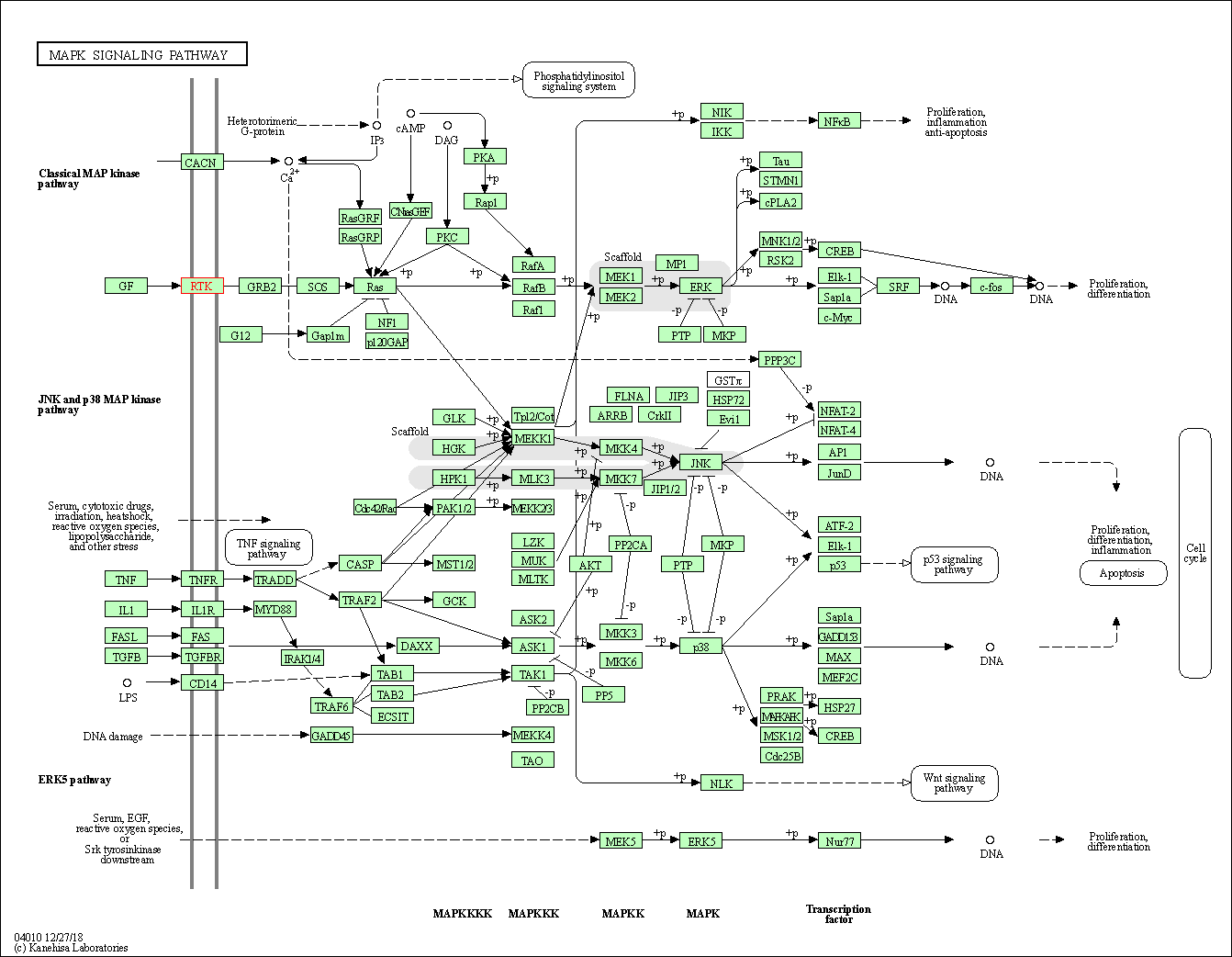
|
| Class: Environmental Information Processing => Signal transduction | Pathway Hierarchy | ||
| Ras signaling pathway | hsa04014 | Affiliated Target |
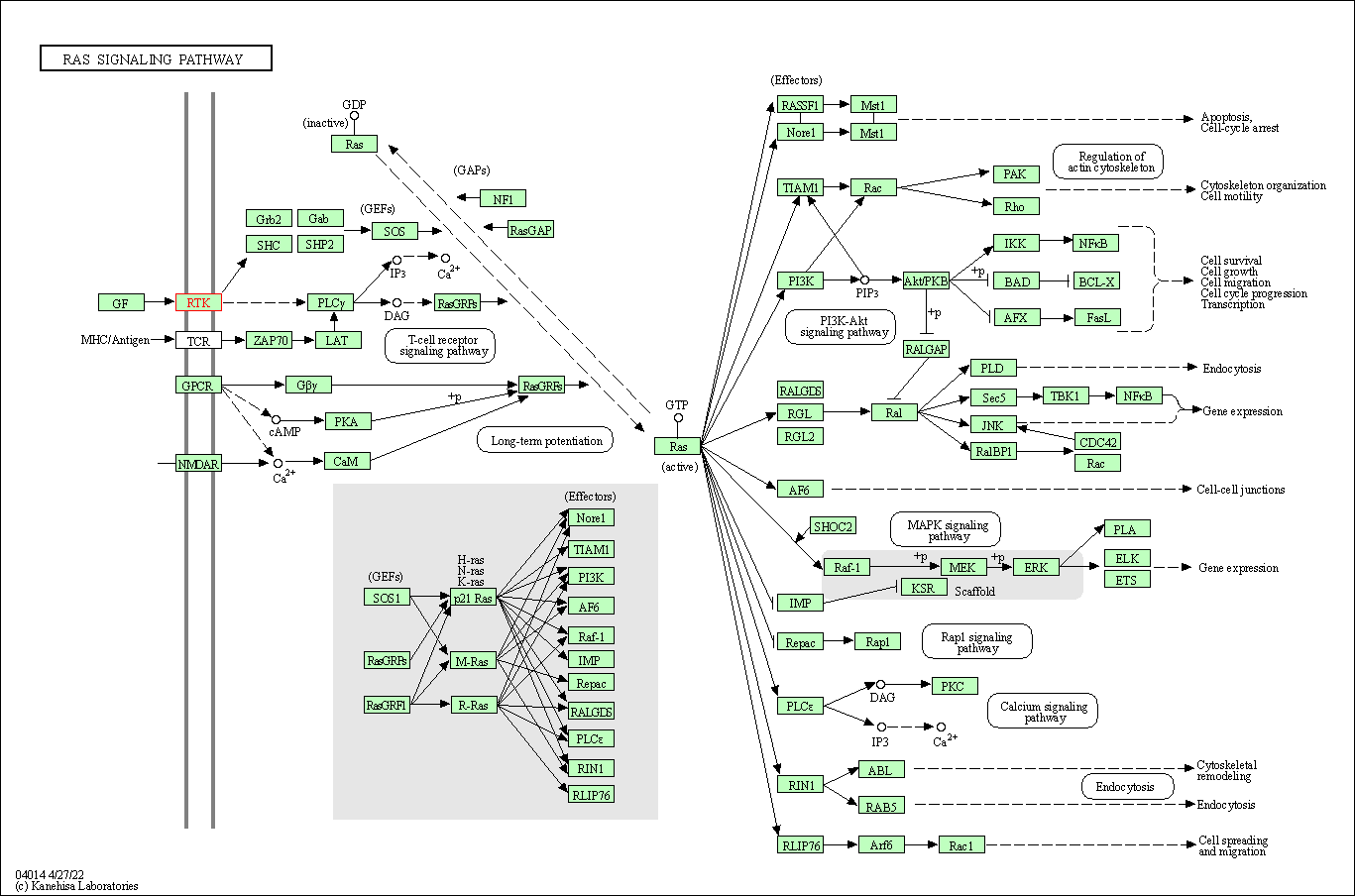
|
| Class: Environmental Information Processing => Signal transduction | Pathway Hierarchy | ||
| Rap1 signaling pathway | hsa04015 | Affiliated Target |
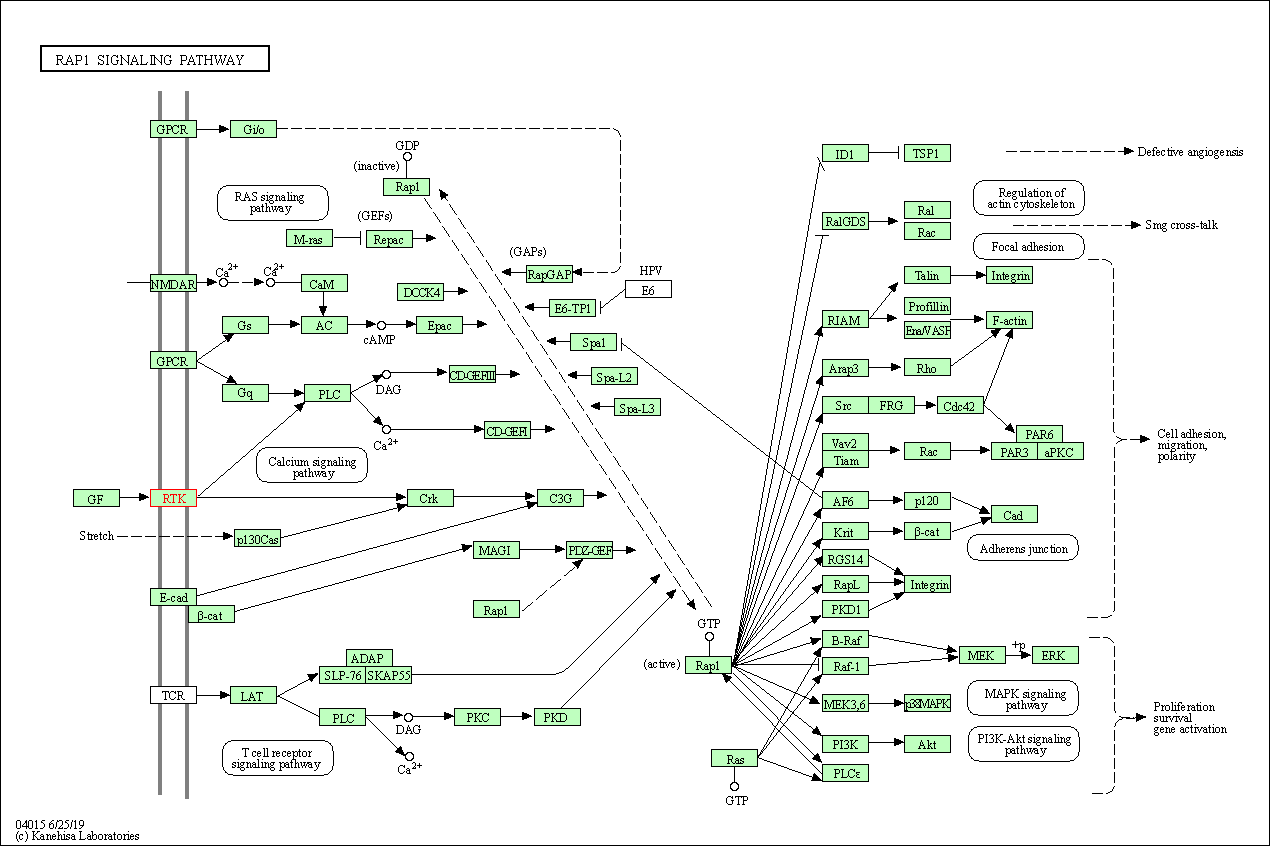
|
| Class: Environmental Information Processing => Signal transduction | Pathway Hierarchy | ||
| Calcium signaling pathway | hsa04020 | Affiliated Target |
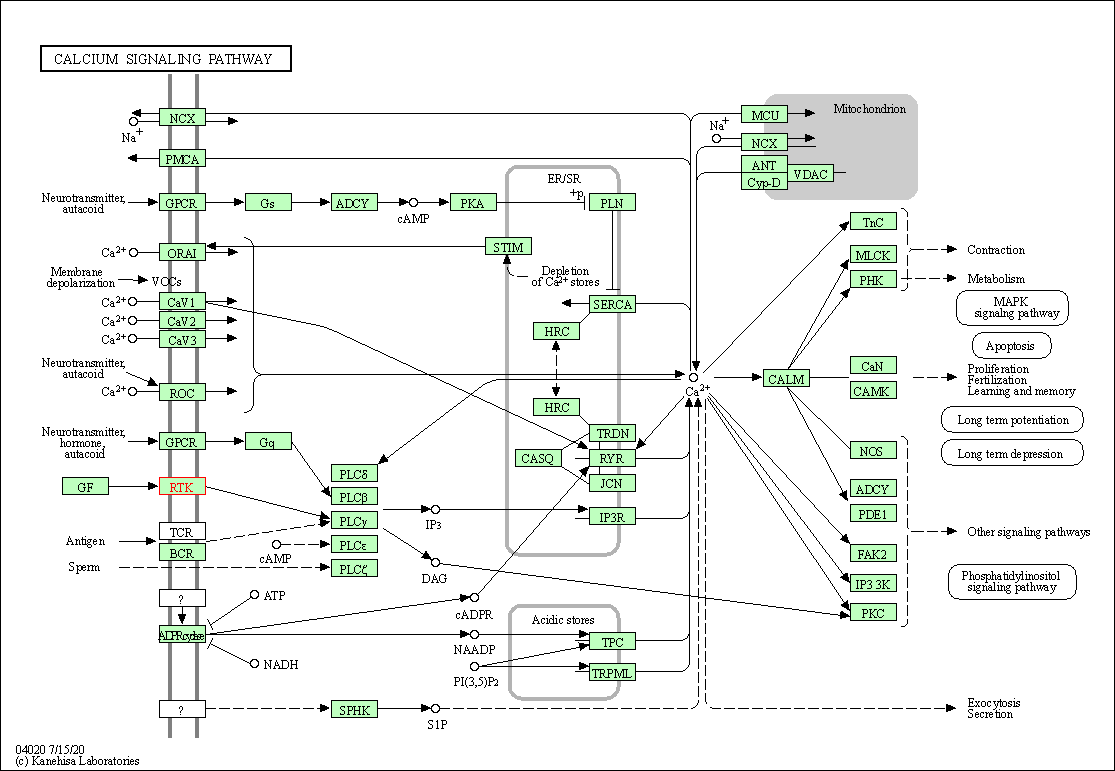
|
| Class: Environmental Information Processing => Signal transduction | Pathway Hierarchy | ||
| Phospholipase D signaling pathway | hsa04072 | Affiliated Target |
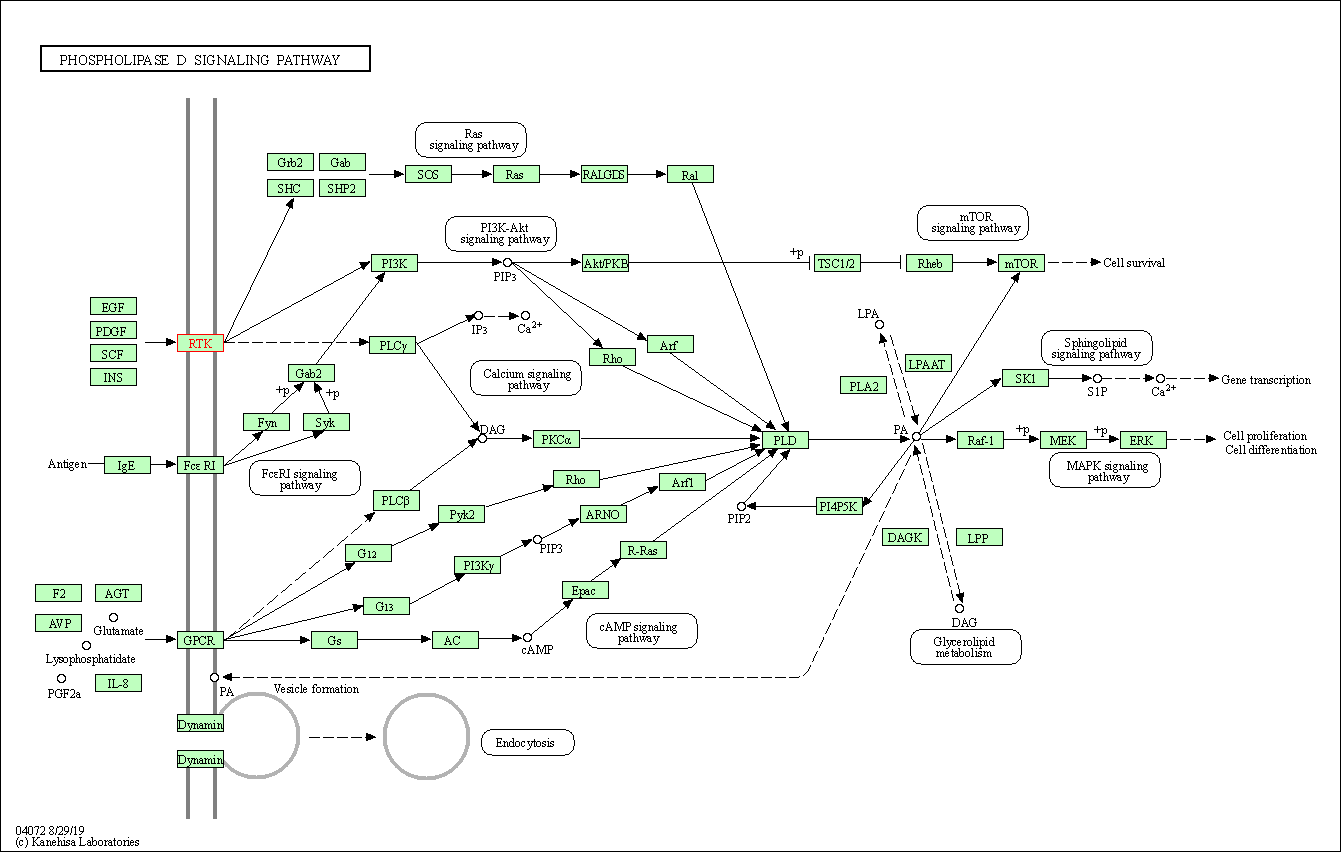
|
| Class: Environmental Information Processing => Signal transduction | Pathway Hierarchy | ||
| Endocytosis | hsa04144 | Affiliated Target |

|
| Class: Cellular Processes => Transport and catabolism | Pathway Hierarchy | ||
| PI3K-Akt signaling pathway | hsa04151 | Affiliated Target |
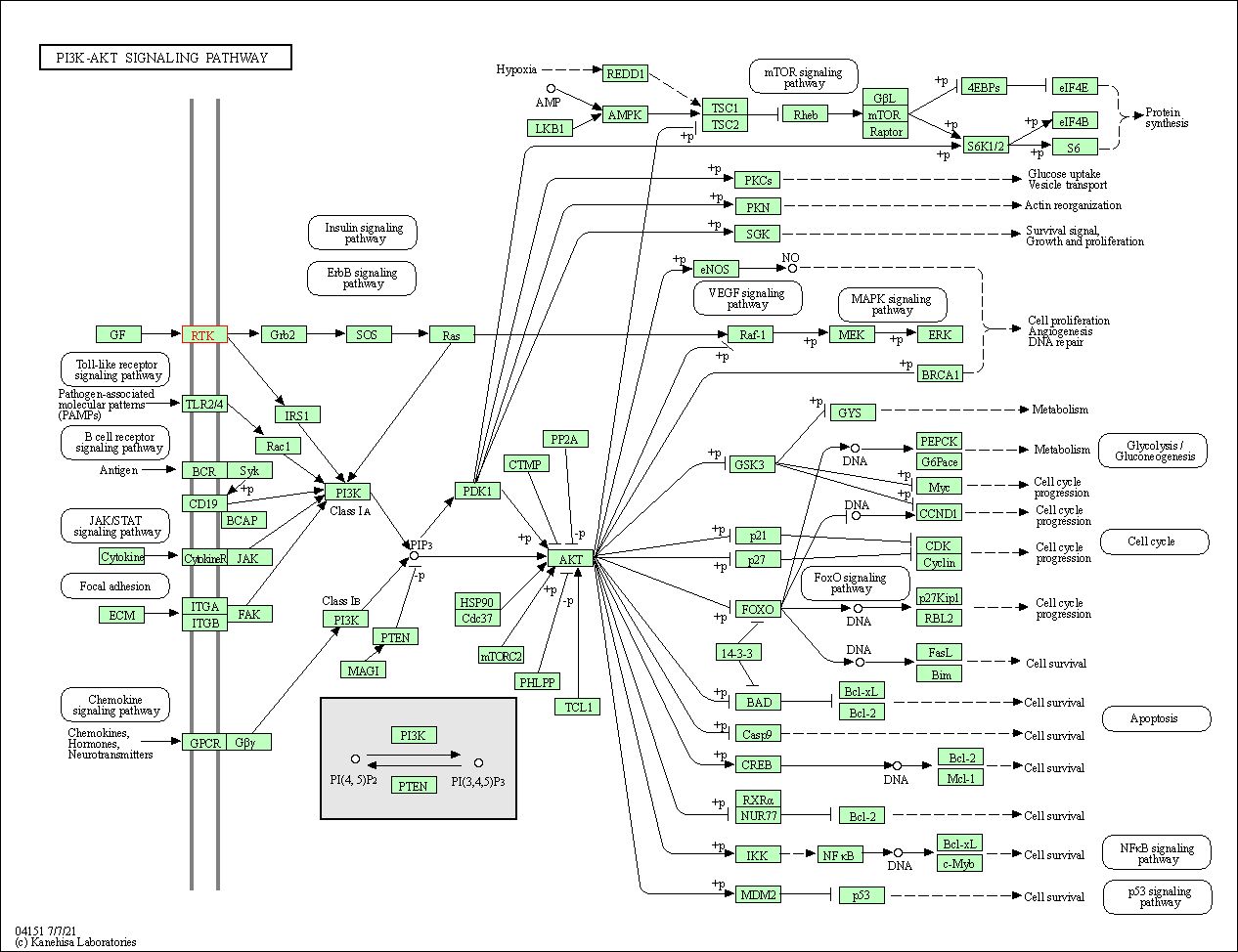
|
| Class: Environmental Information Processing => Signal transduction | Pathway Hierarchy | ||
| Focal adhesion | hsa04510 | Affiliated Target |
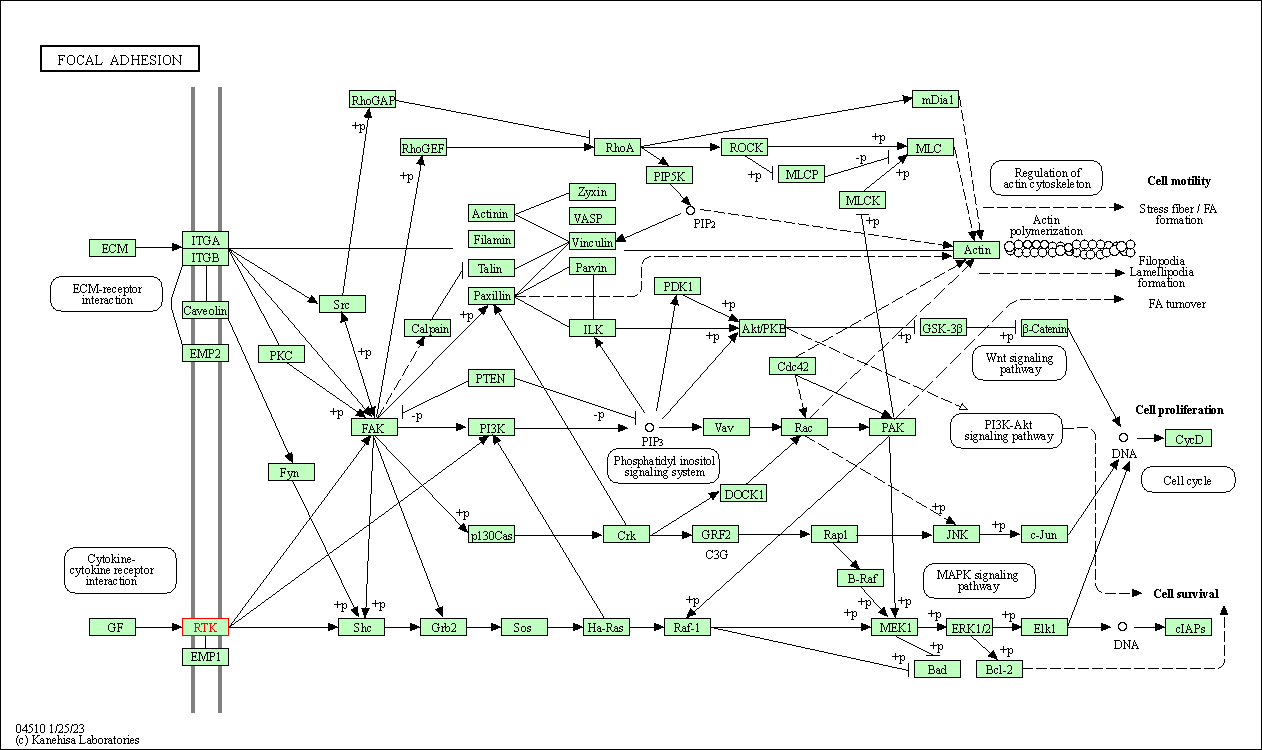
|
| Class: Cellular Processes => Cellular community - eukaryotes | Pathway Hierarchy | ||
| Gap junction | hsa04540 | Affiliated Target |
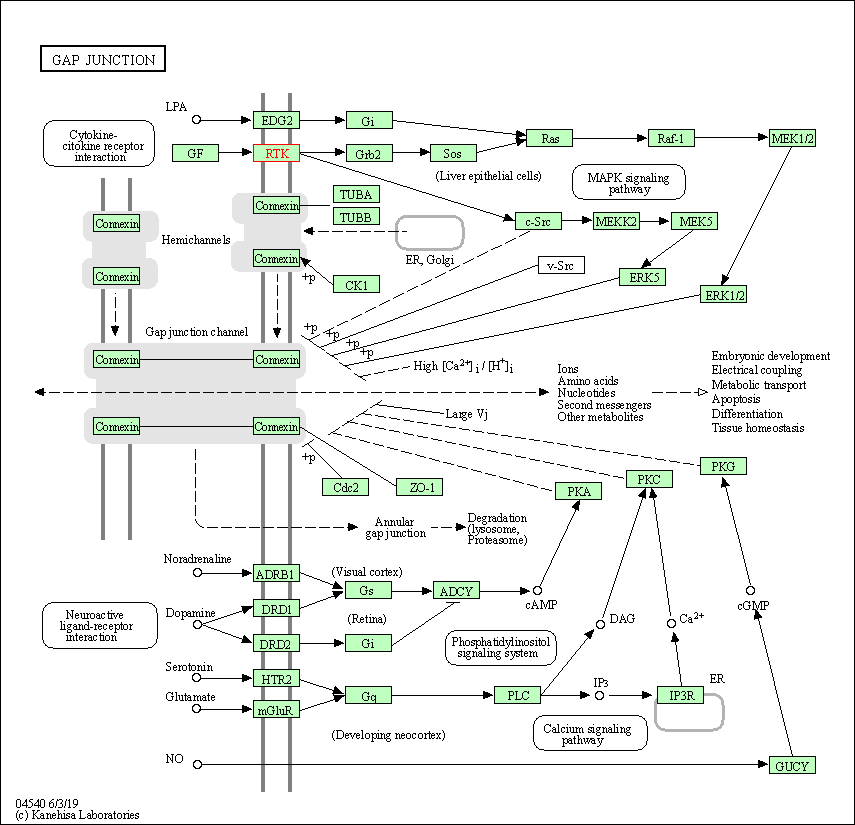
|
| Class: Cellular Processes => Cellular community - eukaryotes | Pathway Hierarchy | ||
| JAK-STAT signaling pathway | hsa04630 | Affiliated Target |

|
| Class: Environmental Information Processing => Signal transduction | Pathway Hierarchy | ||
| Regulation of actin cytoskeleton | hsa04810 | Affiliated Target |
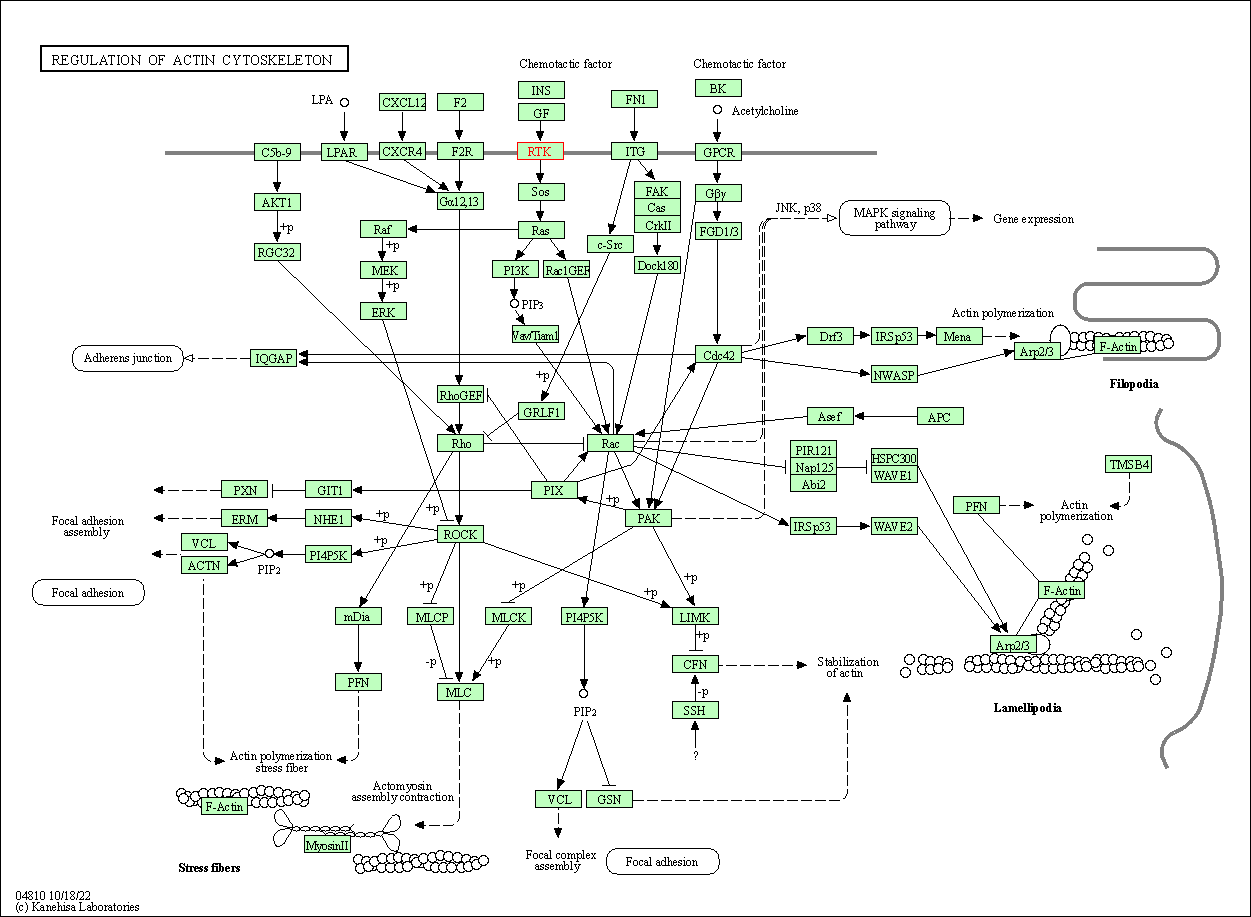
|
| Class: Cellular Processes => Cell motility | Pathway Hierarchy | ||
| Click to Show/Hide the Information of Affiliated Human Pathways | |||
| Degree | 15 | Degree centrality | 1.61E-03 | Betweenness centrality | 1.09E-04 |
|---|---|---|---|---|---|
| Closeness centrality | 2.32E-01 | Radiality | 1.41E+01 | Clustering coefficient | 4.29E-01 |
| Neighborhood connectivity | 5.58E+01 | Topological coefficient | 1.58E-01 | Eccentricity | 12 |
| Download | Click to Download the Full PPI Network of This Target | ||||
| Chemical Structure based Activity Landscape of Target | Top |
|---|---|
| Drug Property Profile of Target | Top | |
|---|---|---|
| (1) Molecular Weight (mw) based Drug Clustering | (2) Octanol/Water Partition Coefficient (xlogp) based Drug Clustering | |
|
|
||
| (3) Hydrogen Bond Donor Count (hbonddonor) based Drug Clustering | (4) Hydrogen Bond Acceptor Count (hbondacc) based Drug Clustering | |
|
|
||
| (5) Rotatable Bond Count (rotbonds) based Drug Clustering | (6) Topological Polar Surface Area (polararea) based Drug Clustering | |
|
|
||
| "RO5" indicates the cutoff set by lipinski's rule of five; "D123AB" colored in GREEN denotes the no violation of any cutoff in lipinski's rule of five; "D123AB" colored in PURPLE refers to the violation of only one cutoff in lipinski's rule of five; "D123AB" colored in BLACK represents the violation of more than one cutoffs in lipinski's rule of five | ||
| Co-Targets | Top | |||||
|---|---|---|---|---|---|---|
| Co-Targets | ||||||
| Target Poor or Non Binders | Top | |||||
|---|---|---|---|---|---|---|
| Target Poor or Non Binders | ||||||
| Target Regulators | Top | |||||
|---|---|---|---|---|---|---|
| Target-regulating microRNAs | ||||||
| Target-interacting Proteins | ||||||
| Target Profiles in Patients | Top | |||||
|---|---|---|---|---|---|---|
| Target Expression Profile (TEP) | ||||||
| Drug Resistance Mutation (DRM) | ||||||
| Target-Related Models and Studies | Top | |||||
|---|---|---|---|---|---|---|
| Target Validation | ||||||
| References | Top | |||||
|---|---|---|---|---|---|---|
| REF 1 | Discovery of 5-[5-fluoro-2-oxo-1,2- dihydroindol-(3Z)-ylidenemethyl]-2,4- dimethyl-1H-pyrrole-3-carboxylic acid (2-diethylaminoethyl)amide, a novel... J Med Chem. 2003 Mar 27;46(7):1116-9. | |||||
| REF 2 | Drugs@FDA. U.S. Food and Drug Administration. U.S. Department of Health Human Services. 2020 | |||||
| REF 3 | 2016 FDA drug approvals. Nat Rev Drug Discov. 2017 Feb 2;16(2):73-76. | |||||
| REF 4 | Drugs@FDA. U.S. Food and Drug Administration. U.S. Department of Health Human Services. 2020 | |||||
| REF 5 | URL: http://www.guidetopharmacology.org Nucleic Acids Res. 2015 Oct 12. pii: gkv1037. The IUPHAR/BPS Guide to PHARMACOLOGY in 2016: towards curated quantitative interactions between 1300 protein targets and 6000 ligands. (Ligand id: 6974). | |||||
| REF 6 | 2008 FDA drug approvals. Nat Rev Drug Discov. 2009 Feb;8(2):93-6. | |||||
| REF 7 | URL: http://www.guidetopharmacology.org Nucleic Acids Res. 2015 Oct 12. pii: gkv1037. The IUPHAR/BPS Guide to PHARMACOLOGY in 2016: towards curated quantitative interactions between 1300 protein targets and 6000 ligands. (Ligand id: 7882). | |||||
| REF 8 | Trusted, scientifically sound profiles of drug programs, clinical trials, safety reports, and company deals, written by scientists. Springer. 2015. Adis Insight (drug id 800015430) | |||||
| REF 9 | URL: http://www.guidetopharmacology.org Nucleic Acids Res. 2015 Oct 12. pii: gkv1037. The IUPHAR/BPS Guide to PHARMACOLOGY in 2016: towards curated quantitative interactions between 1300 protein targets and 6000 ligands. (Ligand id: 7649). | |||||
| REF 10 | ClinicalTrials.gov (NCT02135107) A Double-blind Comparative Study of the Efficacy and Safety of E3810 10mg Once and Twice Daily in Maintenance Therapy for PPI Resistant Gastroesophageal Reflux Disease Patients. U.S. National Institutes of Health. | |||||
| REF 11 | URL: http://www.guidetopharmacology.org Nucleic Acids Res. 2015 Oct 12. pii: gkv1037. The IUPHAR/BPS Guide to PHARMACOLOGY in 2016: towards curated quantitative interactions between 1300 protein targets and 6000 ligands. (Ligand id: 7886). | |||||
| REF 12 | Metabolism and bioactivation of famitinib, a novel inhibitor of receptor tyrosine kinase, in cancer patients. Br J Pharmacol. 2013 Apr;168(7):1687-706. | |||||
| REF 13 | Clinical pipeline report, company report or official report of MedImmune (2011). | |||||
| REF 14 | URL: http://www.guidetopharmacology.org Nucleic Acids Res. 2015 Oct 12. pii: gkv1037. The IUPHAR/BPS Guide to PHARMACOLOGY in 2016: towards curated quantitative interactions between 1300 protein targets and 6000 ligands. (Ligand id: 7932). | |||||
| REF 15 | Phase 1B study of amuvatinib in combination with five standard cancer therapies in adults with advanced solid tumors. Cancer Chemother Pharmacol. 2014 Jul;74(1):195-204. | |||||
| REF 16 | The receptor tyrosine kinase inhibitor amuvatinib (MP470) sensitizes tumor cells to radio- and chemo-therapies in part by inhibiting homologous recombination. Radiother Oncol. 2011 Oct;101(1):59-65. | |||||
| REF 17 | ClinicalTrials.gov (NCT00570635) A Phase 2 Study of XL820 in Adults With Advanced GIST Resistant to Imatinib and/or Sunitinib. U.S. National Institutes of Health. | |||||
| REF 18 | Cancer stem cell (CSC) inhibitors: a review of recent patents (2012-2015).Expert Opin Ther Pat. 2017 Jul;27(7):753-761. | |||||
| REF 19 | Trusted, scientifically sound profiles of drug programs, clinical trials, safety reports, and company deals, written by scientists. Springer. 2015. Adis Insight (drug id 800000818) | |||||
| REF 20 | Trusted, scientifically sound profiles of drug programs, clinical trials, safety reports, and company deals, written by scientists. Springer. 2015. Adis Insight (drug id 800007988) | |||||
| REF 21 | A phase I study of olaratumab, an anti-platelet-derived growth factor receptor alpha (PDGFRalpha) monoclonal antibody, in patients with advanced solid tumors. Cancer Chemother Pharmacol. 2014 Mar;73(3):595-604. | |||||
| REF 22 | The FLT3 and PDGFR inhibitor crenolanib is a substrate of the multidrug resistance protein ABCB1 but does not inhibit transport function at pharmacologically relevant concentrations.Invest New Drugs.2015 Apr;33(2):300-9. | |||||
| REF 23 | Crenolanib, a PDGFR inhibitor, suppresses lung cancer cell proliferation and inhibits tumor growth in vivo.Onco Targets Ther.2014 Sep 26;7:1761-8. | |||||
| REF 24 | E-3810 is a potent dual inhibitor of VEGFR and FGFR that exerts antitumor activity in multiple preclinical models. Cancer Res. 2011 Feb 15;71(4):1396-405. | |||||
| REF 25 | National Cancer Institute Drug Dictionary (drug id 452042). | |||||
| REF 26 | RET kinase inhibitors: a review of recent patents (2012-2015).Expert Opin Ther Pat. 2017 Jan;27(1):91-99. | |||||
| REF 27 | Antitumor activity of SRI 62-834, a cyclic ether analog of ET-18-OCH3. Lipids. 1987 Nov;22(11):884-90. | |||||
| REF 28 | Phase I clinical trial of CEP-2563 dihydrochloride, a receptor tyrosine kinase inhibitor, in patients with refractory solid tumors. Invest New Drugs. 2004 Nov;22(4):449-58. | |||||
| REF 29 | Novel bis(1H-indol-2-yl)methanones as potent inhibitors of FLT3 and platelet-derived growth factor receptor tyrosine kinase. J Med Chem. 2006 Jun 1;49(11):3101-15. | |||||
| REF 30 | A new series of PDGF receptor tyrosine kinase inhibitors: 3-substituted quinoline derivatives. J Med Chem. 1994 Jul 8;37(14):2129-37. | |||||
| REF 31 | Structure-activity relationships for 1-phenylbenzimidazoles as selective ATP site inhibitors of the platelet-derived growth factor receptor. J Med Chem. 1998 Dec 31;41(27):5457-65. | |||||
| REF 32 | 5,7-Dimethoxy-3-(4-pyridinyl)quinoline is a potent and selective inhibitor of human vascular beta-type platelet-derived growth factor receptor tyro... J Med Chem. 1994 Aug 19;37(17):2627-9. | |||||
| REF 33 | Structure-activity relationships for 5-substituted 1-phenylbenzimidazoles as selective inhibitors of the platelet-derived growth factor receptor. J Med Chem. 1999 Jul 1;42(13):2373-82. | |||||
| REF 34 | Molecular modeling of wild-type and D816V c-Kit inhibition based on ATP-competitive binding of ellipticine derivatives to tyrosine kinases. J Med Chem. 2005 Oct 6;48(20):6194-201. | |||||
| REF 35 | Discovery of a (1H-benzoimidazol-2-yl)-1H-pyridin-2-one (BMS-536924) inhibitor of insulin-like growth factor I receptor kinase with in vivo antitum... J Med Chem. 2005 Sep 8;48(18):5639-43. | |||||
| REF 36 | Antiangiogenic and antitumor activity of a selective PDGFR tyrosine kinase inhibitor, CP-673,451. Cancer Res. 2005 Feb 1;65(3):957-66. | |||||
| REF 37 | Bis(1H-2-indolyl)methanones as a novel class of inhibitors of the platelet-derived growth factor receptor kinase. J Med Chem. 2002 Feb 28;45(5):1002-18. | |||||
| REF 38 | Biochemical and cellular effects of c-Src kinase-selective pyrido[2, 3-d]pyrimidine tyrosine kinase inhibitors. Biochem Pharmacol. 2000 Oct 1;60(7):885-98. | |||||
| REF 39 | Discovery of 5-(arenethynyl) hetero-monocyclic derivatives as potent inhibitors of BCR-ABL including the T315I gatekeeper mutant. Bioorg Med Chem Lett. 2011 Jun 15;21(12):3743-8. | |||||
| REF 40 | The design, synthesis, and biological evaluation of potent receptor tyrosine kinase inhibitors. Bioorg Med Chem Lett. 2012 Aug 1;22(15):4979-85. | |||||
| REF 41 | Targeted polypharmacology: discovery of dual inhibitors of tyrosine and phosphoinositide kinases. Nat Chem Biol. 2008 Nov;4(11):691-9. | |||||
| REF 42 | Biological evaluation of a multi-targeted small molecule inhibitor of tumor-induced angiogenesis. Bioorg Med Chem Lett. 2006 Apr 1;16(7):1950-3. | |||||
| REF 43 | The synthesis and SAR of new 4-(N-alkyl-N-phenyl)amino-6,7-dimethoxyquinazolines and 4-(N-alkyl-N-phenyl)aminopyrazolo[3,4-d]pyrimidines, inhibitors of CSF-1R tyrosine kinase activity, Bioorg. Med. Chem. Lett. 7(4):421-424 (1997). | |||||
| REF 44 | Crystal structure of PDGFRA in complex with imatinib by co-crystallization | |||||
| REF 45 | Crystal structure of PDGFRA in complex with sunitinib by soaking | |||||
If You Find Any Error in Data or Bug in Web Service, Please Kindly Report It to Dr. Zhou and Dr. Zhang.

